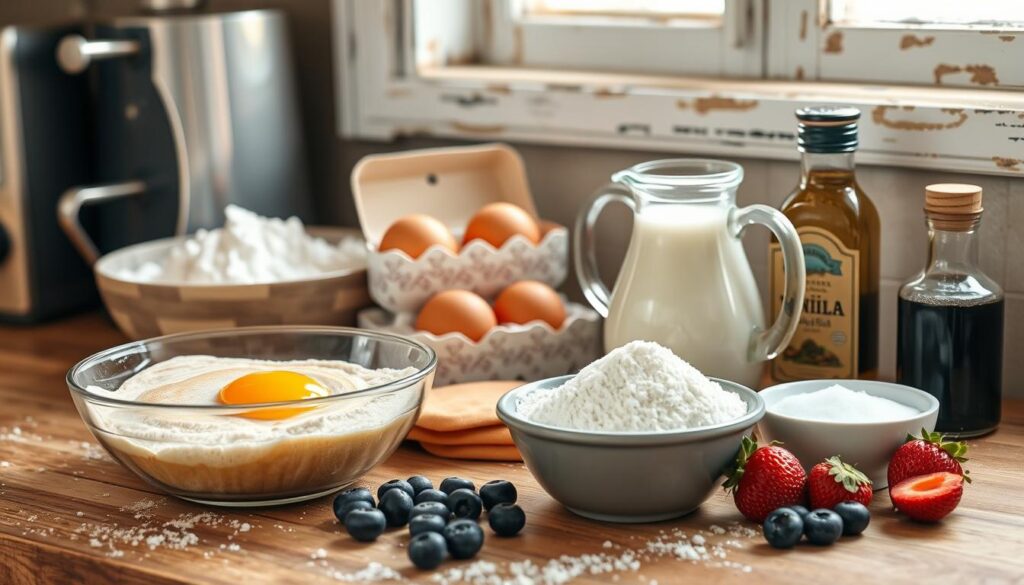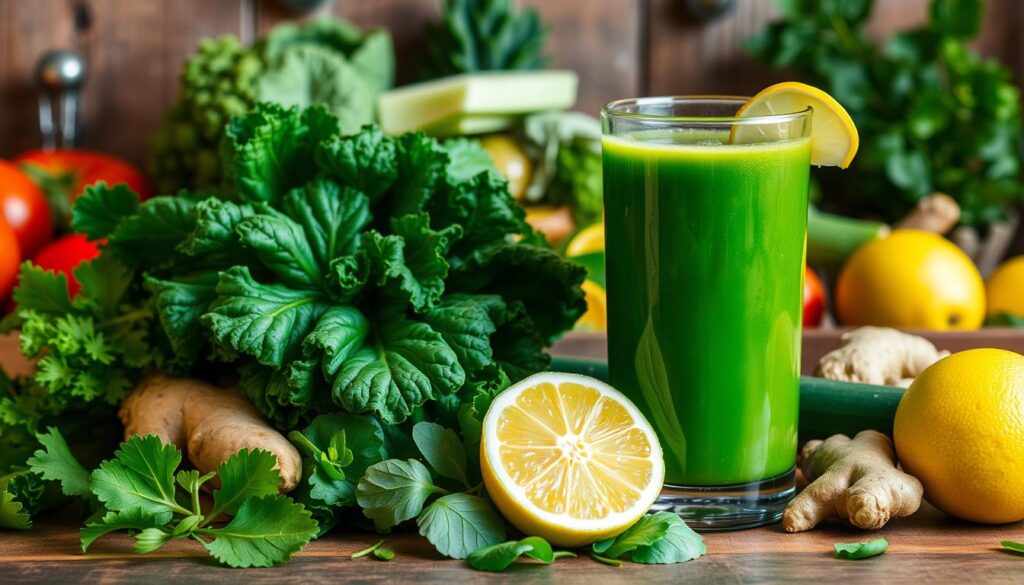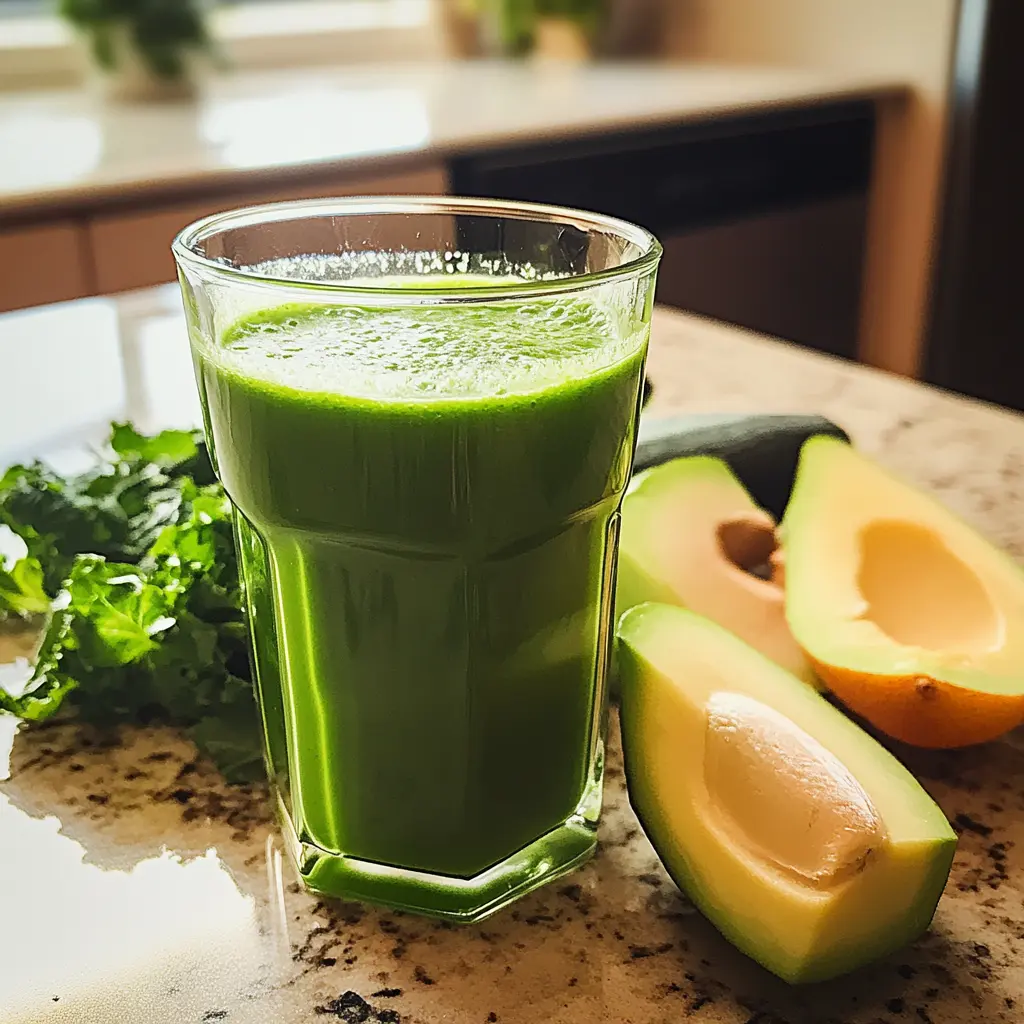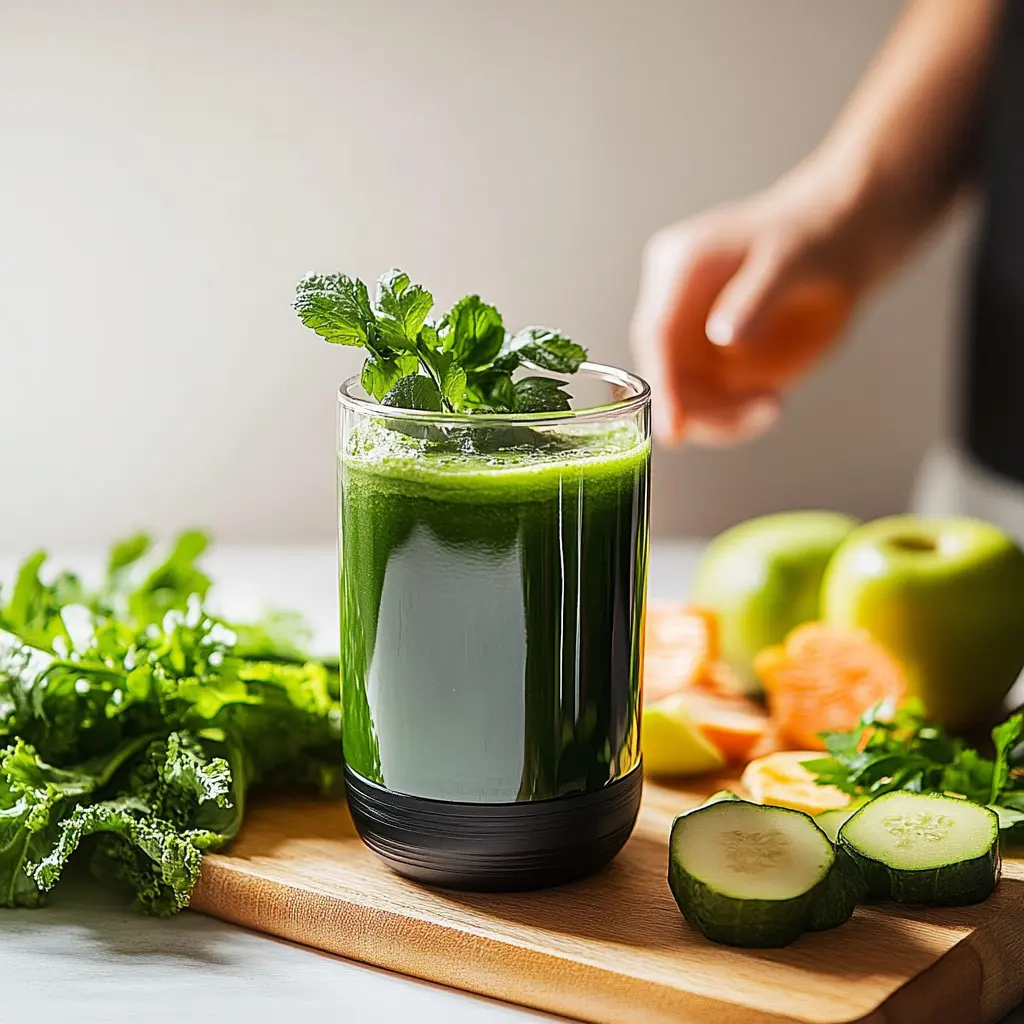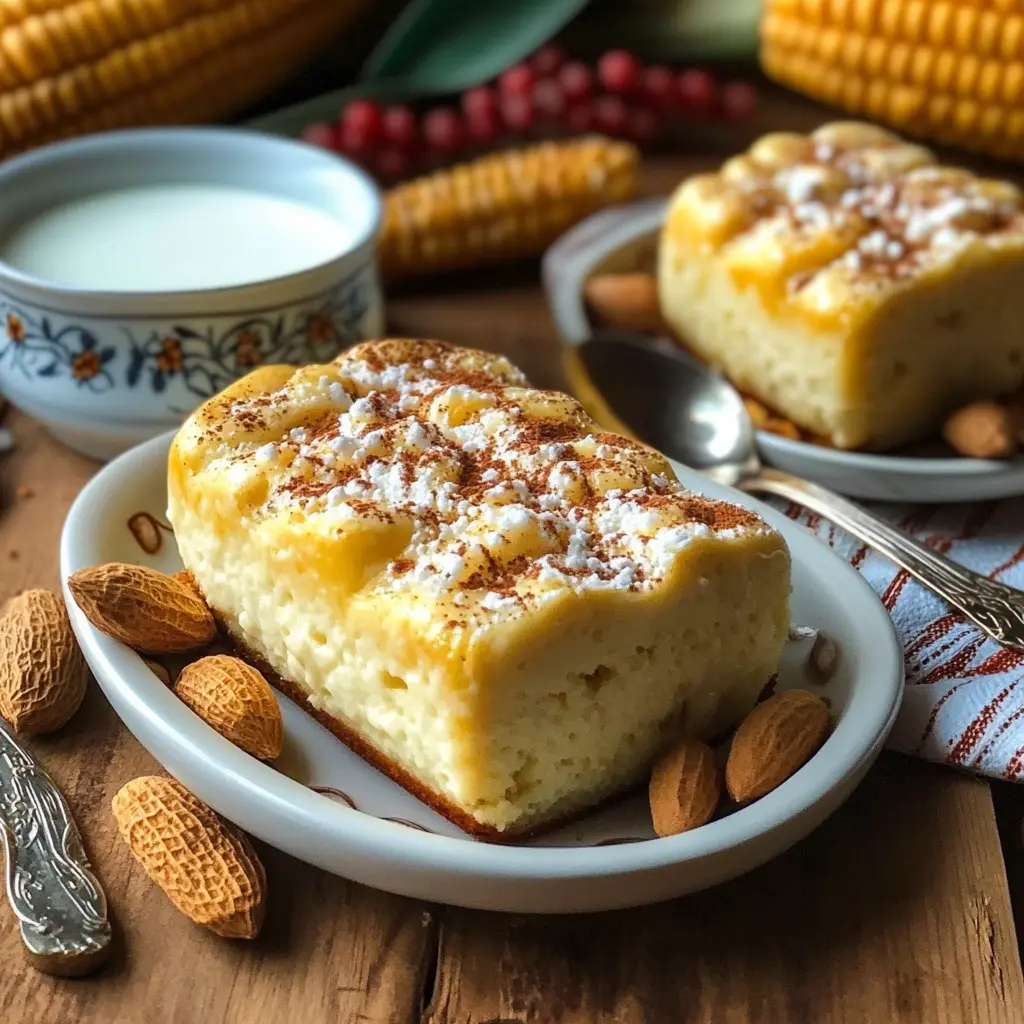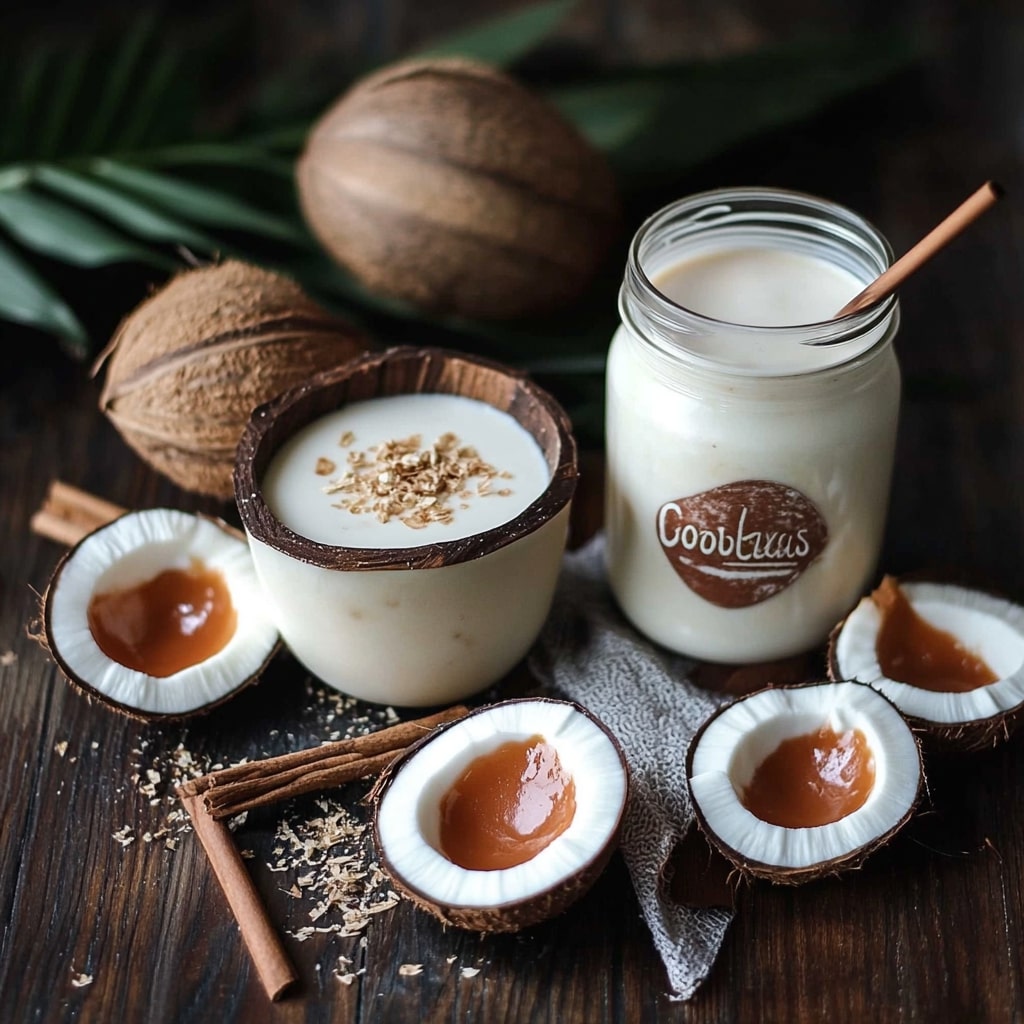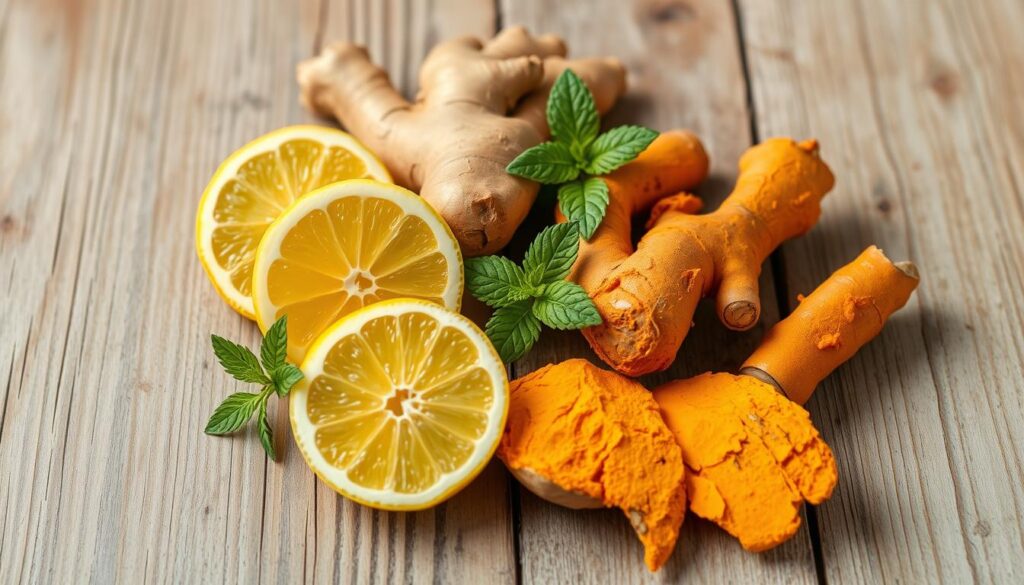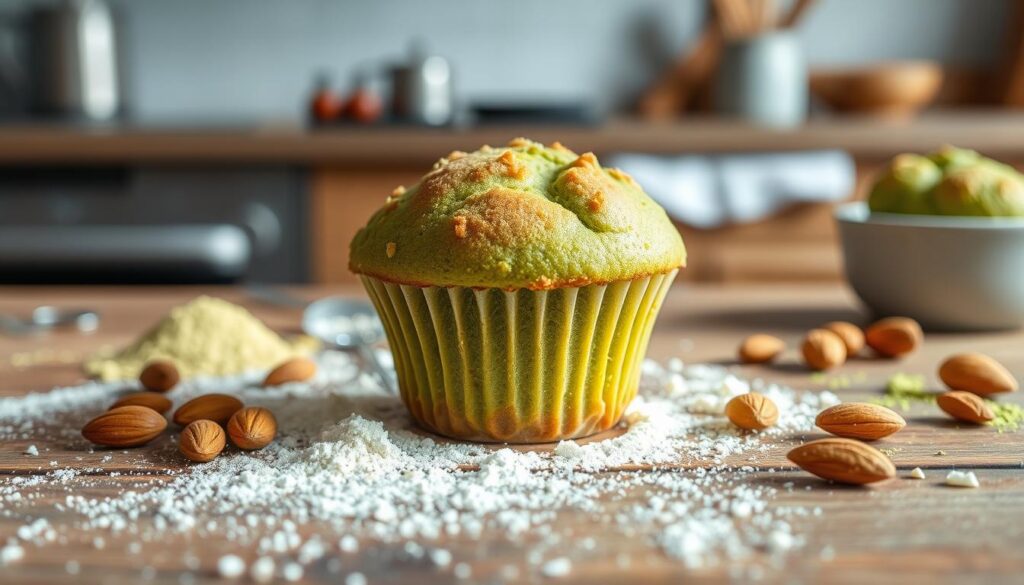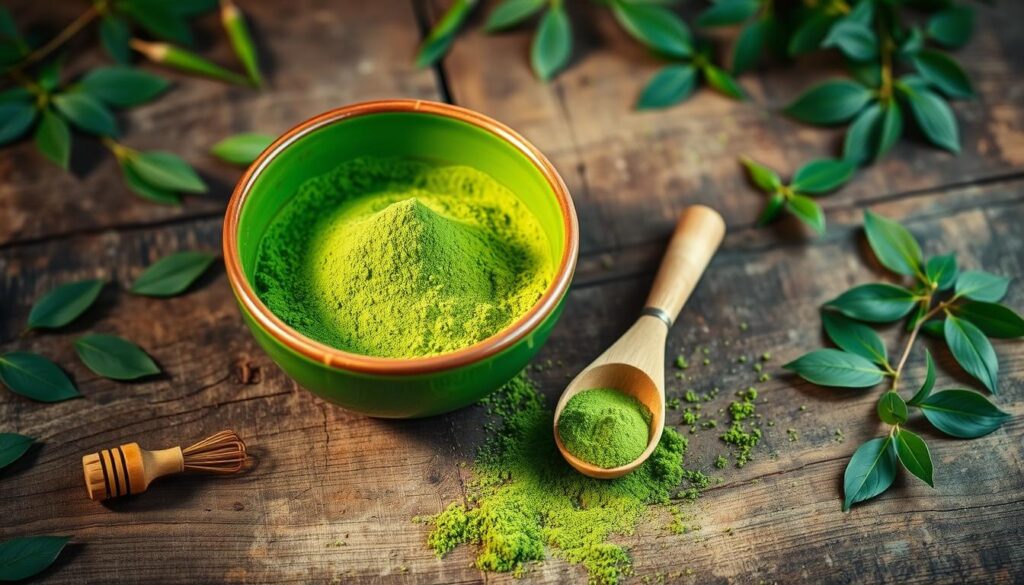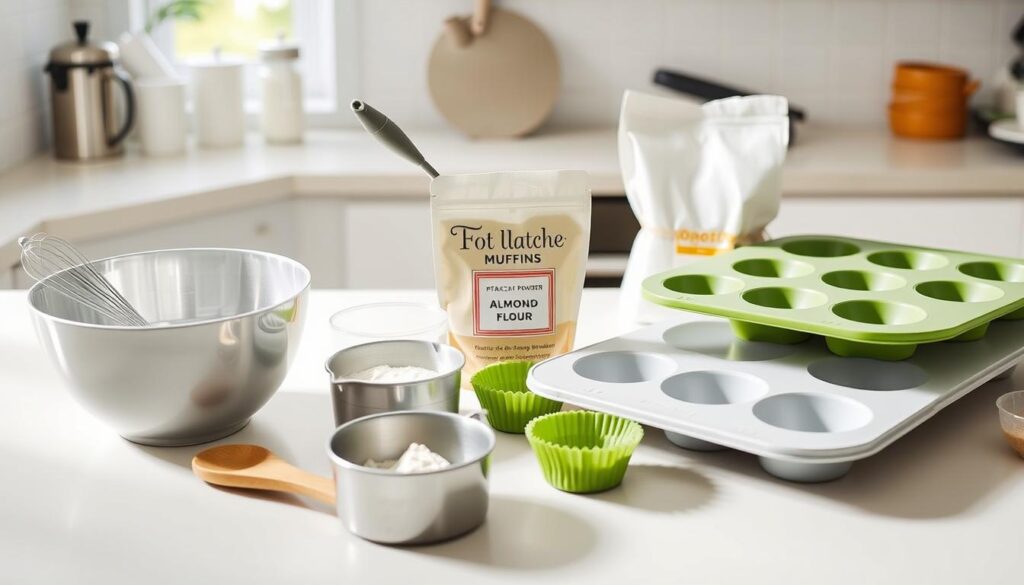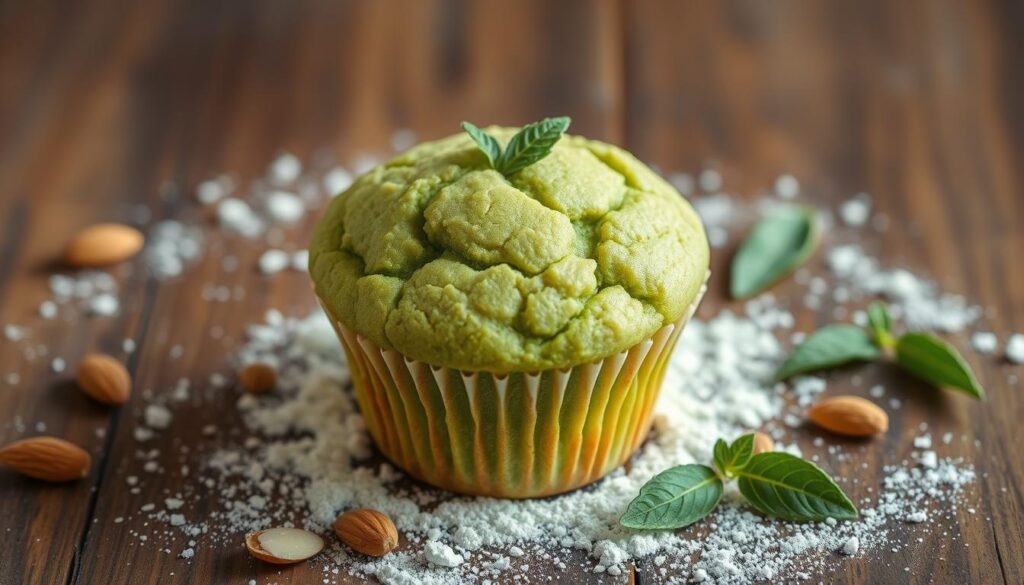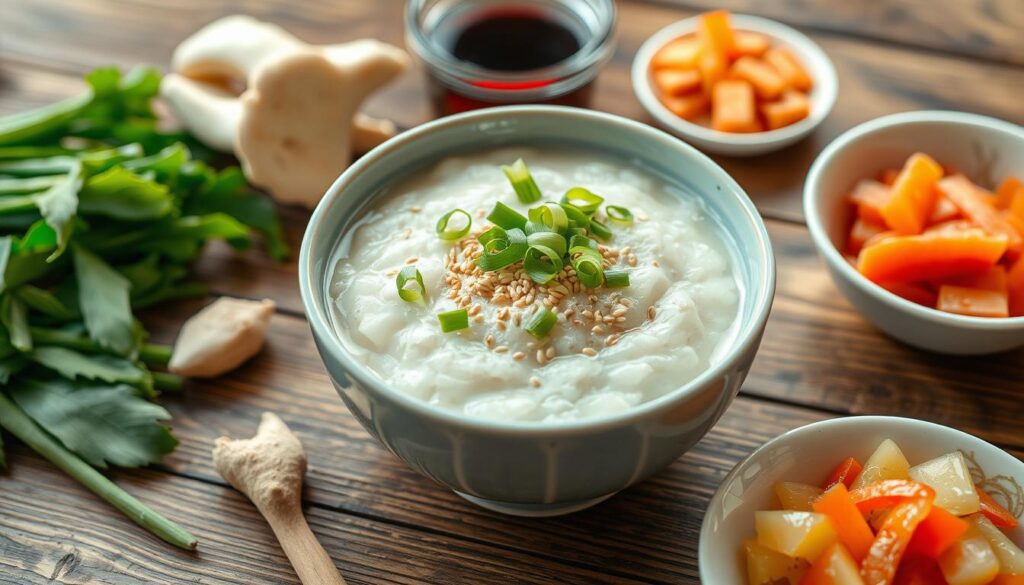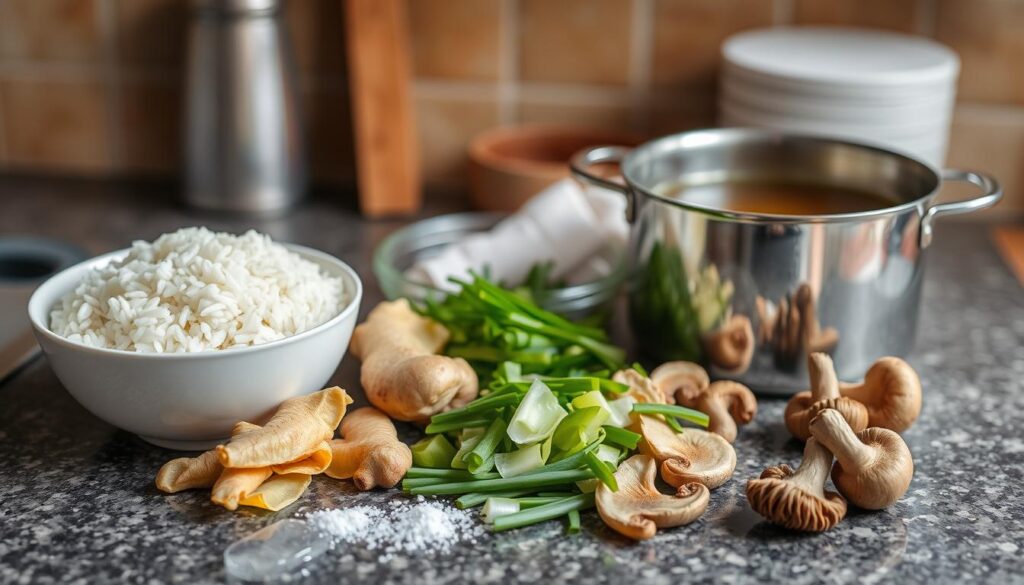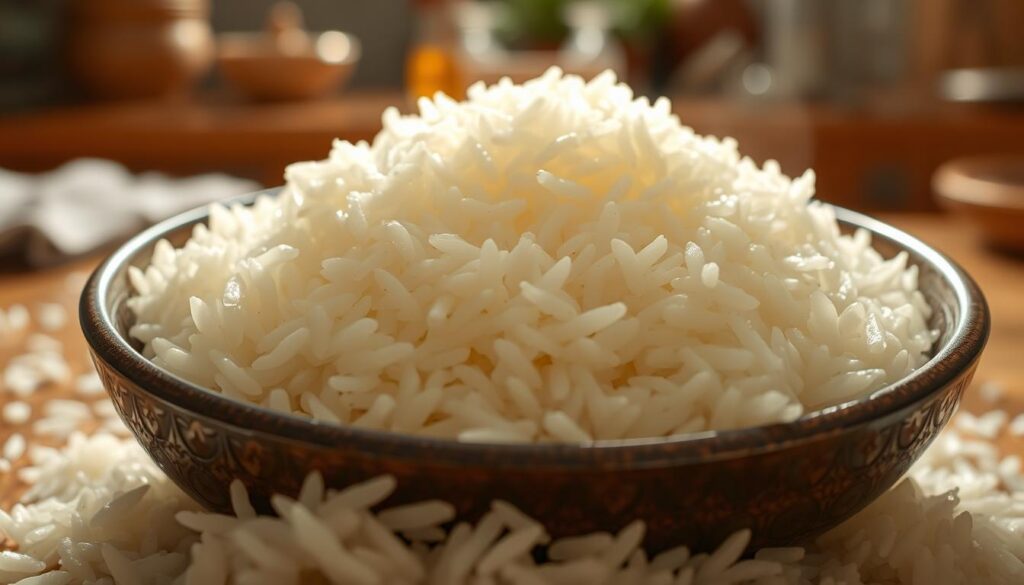As a busy mom, I’m always searching for quick, healthy snacks my family will enjoy. I found this amazing matcha muffin recipe with almond flour. These treats are not only tasty but also gluten-free and full of antioxidants. They’re perfect for breakfast or a guilt-free snack.
Key Takeaways
- Matcha muffins with almond flour are a healthy, gluten-free treat
- Matcha green tea provides powerful antioxidants and a unique, earthy flavor
- Almond flour adds moisture, texture, and nutritional benefits to the muffins
- This recipe is easy to make and ready in just 30 minutes
- Enjoy these muffins for breakfast, a snack, or a delightful dessert
Why These Matcha Almond Flour Muffins Are Your New Favorite Healthy Treat
These green tea muffins are made with matcha powder and almond flour. They are a healthy treat that you’ll love. They are packed with nutrients and fit many diets.
Health Benefits of Matcha Green Tea
Matcha powder is a superfood in these muffins. It’s full of antioxidants that fight off bad stuff in our bodies. It also has caffeine, which gives you a gentle energy boost.
Advantages of Using Almond Flour
Using almond flour makes these muffins gluten-free and full of nutrients. Almond flour has vitamins, minerals, and healthy fats. It’s great for those who follow a paleo or low-carb diet.
Perfect for Special Dietary Needs
- Gluten-free: The almond flour base ensures these muffins are free from gluten, catering to those with dietary restrictions.
- Paleo-friendly: With their simple, whole-food ingredients, these green tea muffins are the perfect paleo-approved treat.
- Potentially keto-friendly: Depending on the specific recipe and portion sizes, these matcha powder muffins may also fit into a ketogenic diet.
Try the mix of matcha and almond flour in these muffins. You’ll see why they’re your new favorite snack!
Essential Ingredients for Perfect Matcha Muffins
Making matcha muffins with almond flour is easy with the right ingredients. You need a few key items for the perfect taste and texture.
The main ingredient is matcha powder. This fine, green tea powder gives your muffins a unique earthy and sweet flavor. Choose a culinary-grade matcha for the best taste.
Almond flour is crucial for structure and a soft crumb. It’s gluten-free and made from ground almonds. It adds a moist, nutty flavor to your vegan muffins.
Sweeteners like maple syrup, coconut sugar, or dates balance the matcha’s bitterness. Flax or chia seeds, applesauce, or mashed bananas act as binding agents. They hold the muffins together without eggs.
Adding vanilla extract, lemon zest, or a pinch of salt can enhance the flavor. These ingredients round out the recipe.
“The key to perfect matcha muffins lies in the careful balance of high-quality ingredients.”
With these ingredients, you’re ready to make delicious, healthy matcha almond flour muffins. They’ll impress your family and friends.
To bake delicious Japanese pastries or gluten-free treats, you need more than ingredients. You’ll also need the right tools and equipment. Let’s look at what you need to make those fluffy matcha muffins with almond flour.
Mixing Equipment Essentials
You’ll need a good mixing bowl set, preferably stainless steel or glass. These bowls are durable and make mixing easy. A strong whisk or hand mixer is also key to get the batter just right.
- A non-stick muffin tin for perfect matcha muffins
- A spoon or scoop for even batter distribution
- A silicone spatula for smooth batter transfer and easy muffin removal
Optional Accessories
While not necessary, some tools can enhance your baking experience:
- A kitchen scale for precise ingredient measurements
- A pastry bag or piping tip for decorative muffin tops
- A cooling rack for even cooling of your muffins
With these tools and equipment, you’re ready to make delicious Japanese pastries and gluten-free treats.
“The right tools can make all the difference in the kitchen, especially when baking up a storm.”
Step-by-Step Matcha Muffin Recipe with Almond Flour
Try the tasty mix of matcha and almond flour in this simple recipe. It’s perfect for those watching their health or following a gluten-free diet. These muffins are light and delicious, making them a favorite treat.
- Preheat your oven to 375°F (190°C). Grease a 12-cup muffin tin or line it with paper liners.
- In a medium bowl, whisk together 2 cups of almond flour, 1/4 cup of matcha powder, 1 teaspoon of baking powder, and 1/4 teaspoon of salt. Set aside.
- In a separate bowl, beat 3 large eggs, 1/2 cup of honey, and 1/3 cup of melted coconut oil until well combined.
- Gently fold the wet ingredients into the dry ingredients until just combined, being careful not to overmix.
- Spoon the batter evenly into the prepared muffin tin, filling each cup about 3/4 full.
- Bake the matcha muffins for 18-22 minutes, or until a toothpick inserted into the center comes out clean.
- Allow the muffins to cool in the tin for 5 minutes before transferring them to a wire rack to cool completely.
Enjoy these tasty matcha muffin recipe with almond flour as a healthy, gluten-free baking treat. The mix of earthy matcha and nutty almond flour makes a satisfying and nutritious snack or breakfast.
Tips for Achieving the Perfect Muffin Texture
Baking healthy, gluten-free muffins is a delicate task. But with the right techniques, you can get a fluffy and tender texture. We’ll explore temperature control, mixing methods, and storage tips to help you excel in gluten-free baking.
Temperature Control Secrets
Keeping the right temperature is key for the perfect muffin. Make sure your oven is at the right temperature before baking. Don’t open the oven door too often, as it can mess with the temperature and baking.
Use the oven light to check on your muffins instead. This way, you can avoid uneven baking.
Mixing Techniques
Mixing your gluten-free batter is important. Avoid overmixing, as it can make the muffins dense and tough. Instead, gently fold the ingredients together until they’re just combined.
This gentle approach will help you get a light and airy texture in your muffins.
Storage Guidelines
- Store your baked and cooled muffins in an airtight container at room temperature for up to 3 days.
- For longer storage, freeze the muffins in an airtight container or resealable bag for up to 3 months.
- To reheat, place the frozen muffins in a 350°F oven for 5-10 minutes, or until warmed through.
By following these tips, you can make gluten-free, healthy muffins that are sure to impress. Enjoy your fluffy, delicious treats!
Customization Options and Add-ins
The beauty of these keto-friendly treats lies in their versatility. The basic matcha muffin recipe with almond flour is already a delightful treat. But, there are endless ways to customize and elevate it to suit your personal preferences or dietary needs. Whether you’re craving a more paleo-friendly snack or simply want to add a personal touch, the options are endless.
One way to customize your matcha muffins is by incorporating various add-ins. Consider adding a handful of chopped nuts like almonds or walnuts for a satisfying crunch. Alternatively, sprinkle in some seeds like chia or flaxseeds for an extra boost of nutrition. For a pop of sweetness, fold in fresh or dried berries such as raspberries, blueberries, or even diced apples.
If you’re following a specialized diet, such as keto or paleo, you can easily adapt the recipe to suit your needs. For a keto-friendly version, simply replace the almond flour with a low-carb alternative like coconut flour or ground flaxseed. To make the muffins paleo-friendly, you can swap out the sweetener for a natural option like honey or maple syrup.
The possibilities are endless when it comes to customizing your matcha muffins. Embrace your creativity and experiment with different flavors and textures to find your personal favorite. Whether you prefer a nutty crunch, a burst of fruity sweetness, or a more specialized dietary approach, these muffins can be tailored to your taste buds and dietary preferences.
Troubleshooting Common Baking Issues
Baking gluten-free muffins with matcha powder can be tricky. But don’t worry, we’ve got you covered! Let’s look at some common problems and how to fix them.
Texture Problems and Solutions
If your matcha muffins are too dense or dry, there are a few things you can do. First, avoid overmixing the batter. This can make the muffins tough and rubbery. Instead, gently mix the ingredients until they’re just combined.
Also, adding a bit more milk or plant-based milk can help. This will keep the muffins moist and fluffy.
If the muffins are too wet or gummy, try adding more almond flour. Or reduce the liquid ingredients a bit. Finding the right balance is key, depending on your ingredients and oven.
Flavor Adjustments
If the matcha flavor isn’t strong enough, add more matcha powder. Start with an extra teaspoon or two in the dry ingredients. If it’s too strong, cut back on the matcha and add a bit more vanilla or sweetener.
To deepen the flavor, add a pinch of cinnamon, a splash of lemon juice, or some chopped nuts or dried fruit. These can enhance the matcha and almond flour flavors.
“Baking is a science, but with a little experimentation, you can find the perfect formula for your gluten-free matcha muffins.”
The joy of baking comes from trying new things. Don’t be afraid to adjust and find the perfect texture and flavor. With patience and persistence, you’ll soon be making amazing matcha muffins.
These healthy muffins are made with matcha and almond flour. They are great for keto-friendly treats and paleo snacks. Let’s explore their benefits!
Each muffin has about 160 calories. It has 12 grams of fat, 8 grams of carbs (4 grams of fiber), and 6 grams of protein. This makes them perfect for keto or paleo diets. They help with weight management and health.
Matcha green tea powder in these muffins adds antioxidants. It’s full of catechins, which are good for your heart and brain.
Using almond flour instead of wheat flour makes them gluten-free. Almond flour is rich in fiber and healthy fats. It helps you feel full and supports your health.
If you want a keto-friendly treat, a paleo snack, or just a tasty, healthy muffin, try this recipe. It’s delicious and good for you.
Serving Suggestions and Pairing Ideas
Make your matcha green tea muffin experience even better with creative serving ideas. These Japanese pastries, made with almond flour, are perfect for many ways of enjoyment.
For a traditional Japanese tea time, pair the green tea muffins with a steaming cup of ceremonial-grade matcha tea. The tea’s earthy, umami flavors will match the muffin’s sweet and grassy notes. Add a bit more matcha powder on top for a beautiful look.
Want something different? Try pairing your Japanese pastries with a fragrant, floral oolong tea. The oolong’s floral notes will blend well with the matcha muffin, making a perfect flavor mix.
For a refreshing twist, serve the muffins with a chilled glass of unsweetened, premium green tea. The tea’s coolness will contrast nicely with the muffin’s warmth, making a refreshing pair.
Feel adventurous? Mix the muffins into a modern Japanese-inspired dessert spread. Place them with other Japanese pastries like mochi, wagashi, or a creamy matcha cheesecake. This makes a stunning and tasty tea-time experience.
No matter how you serve and enjoy these green tea muffins, they’ll surely please your taste buds. They’ll take you to a peaceful, Japanese-inspired moment of indulgence.
Storage Tips and Shelf Life
To keep your matcha almond flour muffins fresh, proper storage is crucial. Once they cool down, store them in an airtight container at room temperature for up to 3 days. For longer freshness, refrigerate them. This will keep their texture and prevent drying out for up to 5 days.
Freezing is the best option for longer storage. Wrap each muffin in plastic wrap or foil, then put them in a freezer-safe bag or container. Frozen muffins can last up to 3 months. To enjoy, thaw at room temperature or reheat in the oven or microwave until warm and fluffy.
For the best texture and flavor, store them in a cool, dry place. Avoid direct sunlight or moisture. With these tips, you can enjoy your homemade treats for days.
FAQ
What are the main ingredients in these matcha muffins?
The main ingredients are high-quality matcha powder, almond flour, and eggs or vegan substitutes. You also need a sweetener and baking soda or powder. Optional add-ins include vanilla extract, lemon zest, or chopped nuts for extra flavor and texture.
Are these matcha muffins gluten-free?
Yes, they are gluten-free because they use almond flour instead of wheat flour. This makes them perfect for those who follow a gluten-free diet.
Can I make these muffins vegan?
Absolutely! To make them vegan, use flax or chia eggs and non-dairy milk or yogurt instead of eggs and dairy products.
What are the health benefits of matcha powder?
Matcha green tea powder is full of antioxidants, vitamins, and minerals. It boosts metabolism, improves focus, and gives a gentle caffeine boost without jitters.
What are the advantages of using almond flour?
Almond flour is a healthy gluten-free option. It’s rich in healthy fats, protein, and fiber. It makes baked goods like these muffins tender and moist.
What equipment do I need to make these matcha muffins?
You’ll need a mixing bowl, whisk, spatula, and a 12-cup muffin tin. A small cookie scoop or ice cream scooper helps portion the batter evenly. A matcha whisk or bamboo brush ensures the matcha powder is mixed well.
How do I store these matcha muffins?
Store them in an airtight container at room temperature for up to 3 days. You can also freeze them for 2-3 months. Thaw at room temperature or reheat briefly in the oven or microwave.
Can I customize these matcha muffins?
Absolutely! You can add chopped nuts, seeds, chocolate chips, or dried fruit. Adjust the sweetness or use different sugar substitutes to fit your diet.
What are some common issues I should troubleshoot when baking these muffins?
Issues like dry texture, trouble rising, or strong matcha flavor can happen. Avoid overmixing, adjust matcha amount, and check your oven temperature. Proper storage and cooling help keep the texture right.
How do these matcha muffins fit into a healthy diet?
These muffins are nutritious and filling. They’re low in carbs, high in fiber and protein, and packed with antioxidants from matcha. They’re great for keto, paleo, or low-carb diets as a healthy snack or breakfast.

